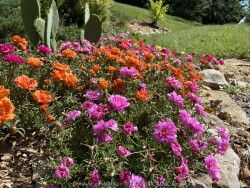

***Description for this plant available with future update!*** Portulaca grandiflora is also known as Mixed Rose Moss (Tropical).
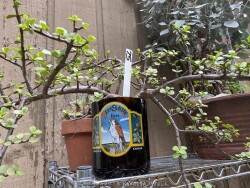

***Description for this plant available with future update!*** Portulacaria afra is also known as Elephant Bush (Tropical)>>>>>> Listed as Edible like other members in the portulaca family


***Tree descriptions available with future update!*** Prunus americana is also known as American Plum
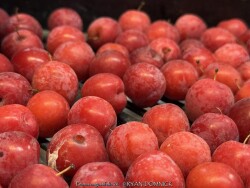

***Shrub descriptions available with future update!***Native Edible Sand Plum, is also known as Prunus angustifolia
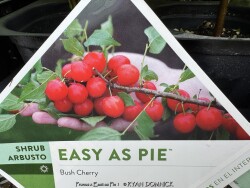

They say life is just a bowl of cherries...and Easy As Pie bush cherry (Prunus x) will give you bowls and bowls of fresh fruit every summer without any spraying or fussy pruning. This is an easy-going, easy-growing bush cherry that takes up just a fraction of the space as a cherry tree but produces abundant crops of very juicy, very tart cherries. It also has none of the disease issues that plague cherry trees, making it an easy choice for any sunny spot in a landscape or garden. Plant one as a standalone, as no pollinator is needed, or imagine an edible hedge with enough fruit for cooking, baking, and canning. White flowers in spring and vivid yellow and orange fall foliage keep it interesting all season long. All Proven Winners® plants are legally propagated, healthy and vigorous, true to name, and tagged with color pictures and growing information.
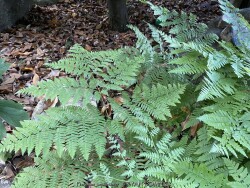

Bracken Fern (Pteridium aquilinum) is planted for its coarse, divided, triangular fronds in a medium green color. Native to all continents in the Northern Hemisphere, it forms large colonies in forests with poor to average soil in sun to shade preferring sandy or peaty acidic soils. It colonizes medium to dry woodland areas, fields, old pastures, thickets, areas with disturbed soils, burned-out areas, and marsh edges. It can handle some Kansas drought in slightly acidic moisture-retentive soils but not full-on dry-shade. Foliage finally dies back to the ground in early autumn with "fiddle-heads" emerging and unfurling in mid-spring. Generally this plant holds its own in Kansas climates but fails to spread very quickly. Leaves can depreciate considerably in extremely hot weather and/or too much sun, particularly if soils are allowed to dry out to extremely. Root rot may occur in wet, poorly drained soils. With proper siting, it can be a "Once it's there, it's there forever" plant! I have seen an established planting thriving on the north side of a house for 20 plus years in Lawrence, KS.


Lungwort (Pulmonoria saccharata) is planted for its unusual evergreen spekled white and green foliage. Foliage maintains well all summer provided that basic cultural conditions are met. Late spring flowers are a bright and colorful mix of blue, purple, and pink on the same plant changing colors as they age. Flowering last about 3-4 weeks and requires no dead-heading as new foliage swallows up dying flower stalks. Native to Europe, it slowly colonizes forests in humusy, medium well-drained soil in part shade to full shade. It can handle a little Kansas drought in in moisture-retentive soils but not full-on dry-shade. Foliage will flatten to the ground during drought then spring back up when moisture is available again. If low temperatures hit 0 degrees F, foliage finally dies back to the ground and re-emerges in early spring. Generally this plant holds its own in Kansas climates but fails to spread much. Leaves can depreciate considerably in extremely hot weather and/or too much sun, particularly if soils are allowed to dry out. Root rot may occur in wet, poorly drained soils. It is worth a try if you have a small spot to fill in a well-tended shade gardens.
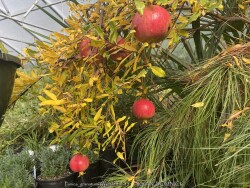

***Description for this plant available with future update!***Hardy Pomegranite (Tropical), is also known as Punica granatum 'Wonderful'
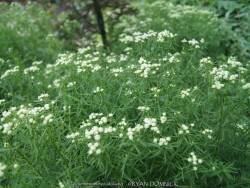

***Description for this perennial available with future update!***Narrow-Leaf Mountain Mint, is also known as Pycanthemum tenuifolium
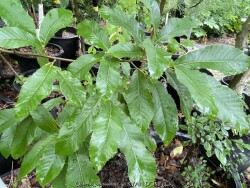

***Tree descriptions available with future update!*** Quercus acutissima is also known as Sawtooth Oak
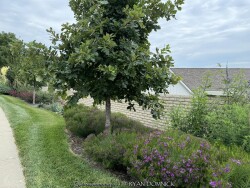

***Tree descriptions available with future update!*** Quercus macrocarpa is also known as Bur Oak
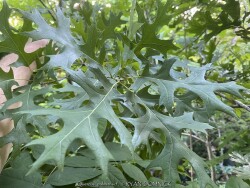

***Tree descriptions available with future update!*** Quercus palustris is also known as Pin Oak
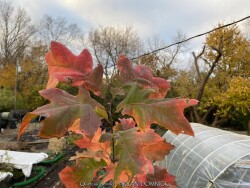

***Tree descriptions available with future update!*** Quercus rubra is also known as Northern Red Oak
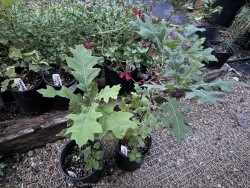

***Tree descriptions available with future update!*** Quercus shumardii is also known as Shumard Oak
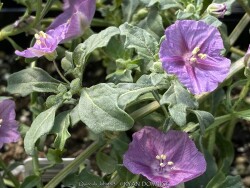

***Description for this perennial available with future update!*** Quincula / Physalis lobata is also known as Purple Ground Cherry.
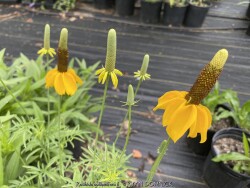

***Description for this perennial available with future update!*** Mexican Hat, is also known as Ratibida columnifera


***Description for this perennial available with future update!***Red Mexican Hat, is also known as Ratibida columnifera 'Red'
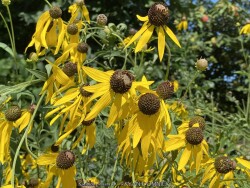

***Description for this perennial available with future update!***Grey-headed Coneflower, is also known as Ratibida pinnata
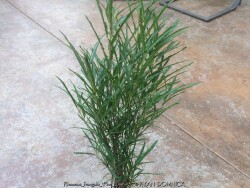

***Shrub descriptions available with future update!***Fine Line Columnar Buckthorn, is also known as Rhamnus frangula 'Fine Line'
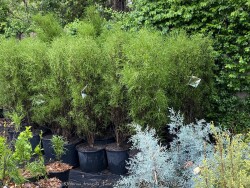

***Shrub descriptions available with future update!***Fine Line Columnar Buckthorn, is also known as Rhamnus frangula 'Fine Line'
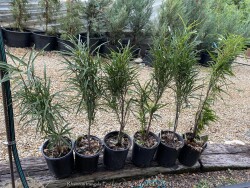

***Shrub descriptions available with future update!***Fine Line Columnar Buckthorn, is also known as Rhamnus frangula 'Fine Line' This item is intended for creating a living fence. Plant 12-18" apart for fastest results. This pack of Fine Line Columnar Buckthorn will cover 8 to 12 linear feet depending on spacing. (Living Fence 8-pack)


***Shrub descriptions available with future update!***Fine Line Columnar Buckthorn, is also known as Rhamnus frangula 'Fine Line'


Needle palm (Rhapidophyllum hystrix) is a very special plant in that it is the world's most cold-hardy palm. Needle palm is native to the lower Southeast US with its original native range probably pushed south during the last Ice Age. This would explain its -20°F cold hardiness rating. Bright green foliage is shiny and fan-like; typical of any fan palm. When grown in a northern climate such as Kansas, growth is pretty slow at first and some winter damage should be expected if temperatures drop below -5 degrees F. It is advisable to mulch the crown of a newly planted Needle Palm with 6 to 8 inches of mulch for the first few years. Established plants get about 3 to 4 feet tall after 10-20 years. Needle Palms tolerate excessive moisture and rain gardens but prefer rich well-drained soil. Needle palm grow in full sun to full shade (much slower growth).They are also notably drought tolerant if grown in full sun but not in dry shade. They do need a hot and humid (Kansas) summer to build up stored energy for the next winter. There have been problems in the Eastern United States with crown-rot from winter moisture but generally in Kansas with pretty dry winters, this has not been a problem. Useful in the landscape as a tropical looking evergreen specimen plant. Unlike other Evergreens, needle palm maintains bright green foliage, not dingy olive green like many conifers. Combine with just about any other flowering plants and most garden themes. This true palm, however, is a must for any tropical theme garden. Mix with hardy banana (Musa basjoo), canna, or crinum lily! Rhapidophyllum hystrix has been planted in our trial gardens and at several residential gardens in Lawrence, KS (zone 6a) 10-15 years ago. During the arctic blast of February, 2021, lows down to -17 degrees F on Feb 16th, 2021 were recorded. The longevity of this cold blast was also impressive: 10 days on a row with highs of 10-15 degrees F or lower, 8 nights of lows in the single digits and negatives, and 36 straight hours of 0 degrees F and mostly lower. Minimal foliage damage resulted on established plants, more damage occured on small plants but they recovered by mid-summer.
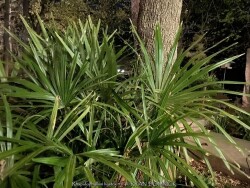

Needle palm (Rhapidophyllum hystrix) is a very special plant in that it is the world's most cold-hardy palm. Needle palm is native to the lower Southeast US with its original native range probably pushed south during the last Ice Age. This would explain its -20°F cold hardiness rating. Bright green foliage is shiny and fan-like; typical of any fan palm. When grown in a northern climate such as Kansas, growth is pretty slow at first and some winter damage should be expected if temperatures drop below -5 degrees F. It is advisable to mulch the crown of a newly planted Needle Palm with 6 to 8 inches of mulch for the first few years. Established plants get about 3 to 4 feet tall after 10-20 years. Needle Palms tolerate excessive moisture and rain gardens but prefer rich well-drained soil. Needle palm grow in full sun to full shade (much slower growth).They are also notably drought tolerant if grown in full sun but not in dry shade. They do need a hot and humid (Kansas) summer to build up stored energy for the next winter. There have been problems in the Eastern United States with crown-rot from winter moisture but generally in Kansas with pretty dry winters, this has not been a problem. Useful in the landscape as a tropical looking evergreen specimen plant. Unlike other Evergreens, needle palm maintains bright green foliage, not dingy olive green like many conifers. Combine with just about any other flowering plants and most garden themes. This true palm, however, is a must for any tropical theme garden. Mix with hardy banana (Musa basjoo), canna, or crinum lily! Rhapidophyllum hystrix has been planted in our trial gardens and at several residential gardens in Lawrence, KS (zone 6a) 10-15 years ago. During the arctic blast of February, 2021, lows down to -17 degrees F on Feb 16th, 2021 were recorded. The longevity of this cold blast was also impressive: 10 days on a row with highs of 10-15 degrees F or lower, 8 nights of lows in the single digits and negatives, and 36 straight hours of 0 degrees F and mostly lower. Minimal foliage damage resulted on established plants, more damage occured on small plants but they recovered by mid-summer.


***Shrub descriptions available with future update!*** Rhodotypos scandens is also known as Black Dry-Shade Jetbead.
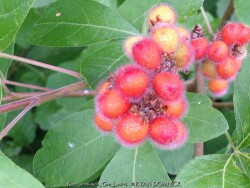

***Shrub descriptions available with future update!*** Rhus aromatica is also known as Dry Shade Fragrant Sumac.
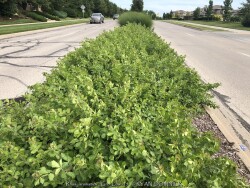

Gro-low sumac (Rhus aromatica 'Gro-low') is a dwarf spreading cultivar of Rhus aromatica native to much of the central United States including Kansas. It features bright green leaves that turn brilliant red in the fall. Light yellow flowers and occasional red berries are also ornamental features. This sumac is commonly grown as a spreading groundcover shrub for difficult areas. It will grow in full sun or full shade in medium to dry soils including dry-shade. However, fall color is quite a bit reduced in full shade. In the landscape, it is commonly used as large mass planting on hills. Because of its tolerance for adverse conditions including poor soil and rock, it is often one of the last resort plants that will survive in certain areas. It competes well under large shade trees and helps absorb leaf litter allowing it to break down and add nutrients back to the soil. It is important to keep on the dry side to discourage root rot disease. This plant also does well in hot dry parking lot islands or along busy roads. Plants adapt well to hot south or west sides of the house enduring temperatures of over 100 degrees F with no foliage burn. Plants can also be planted on the north side of a house being extremely cold hardy with no winterkill. Another great spot is planting on top of a retaining wall allowing it to cascade down. We do not recommend planting in small areas or in spaces that it will overrun neighboring plants. Unlike other sumac, it only spreads above ground as horizontally growing stems touch the ground and root. This does make maintenance easier to control the spread of the plant versus digging out rhizomes. Considered one of the most versatile and best plants for solving your most difficult landscape challenges.
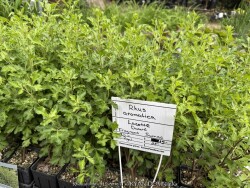

Gro-low sumac (Rhus aromatica 'Lacette') is a dwarf spreading cultivar of Rhus aromatica native to much of the central United States including Kansas. It differs from "Gro-low' with its fine textured leaves. It features bright foliage that turn brilliant red in the fall. Light yellow flowers and occasional red berries are also ornamental features. This sumac is commonly grown as a spreading groundcover shrub for difficult areas. It will grow in full sun or full shade in medium to dry soils including dry-shade. However, fall color is quite a bit reduced in full shade. In the landscape, it is commonly used as large mass planting on hills. Because of its tolerance for adverse conditions including poor soil and rock, it is often one of the last resort plants that will survive in certain areas. It competes well under large shade trees and helps absorb leaf litter allowing it to break down and add nutrients back to the soil. It is important to keep on the dry side to discourage root rot disease. This plant also does well in hot dry parking lot islands or along busy roads. Plants adapt well to hot south or west sides of the house enduring temperatures of over 100 degrees F with no foliage burn. Plants can also be planted on the north side of a house being extremely cold hardy with no winterkill. Another great spot is planting on top of a retaining wall allowing it to cascade down. We do not recommend planting in small areas or in spaces that it will overrun neighboring plants. Unlike other sumac, it only spreads above ground as horizontally growing stems touch the ground and root. This does make maintenance easier to control the spread of the plant versus digging out rhizomes. Considered one of the most versatile and best plants for solving your most difficult landscape challenges.
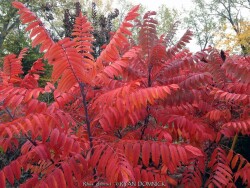

***Shrub descriptions available with future update!*** Rhus glabra is also known as Smooth Sumac >>>>>>>>>>>>>Smooth Sumac (Rhus glabra) features bright green leaves that turn brilliant red in the fall. Light yellow flowers and occasional red berries are also ornamental features.>>>>>>It will thrive in full sun in medium to bone dry soils. In the landscape, it is commonly used as large mass planting on hills and berms. Because of its tolerance for adverse conditions including poor soil and rock, it is often one of the last resort plants that will survive in certain areas. This plant also does well in hot dry parking lot islands (hell-strips) or along busy roads. Plants adapt well to hot south or west sides of the house enduring temperatures of over 100 degrees F with no foliage burn. Another great spot is planting on top of a retaining wall allowing it to cascade down. We do not recommend planting in small areas or in spaces that it will overrun neighboring plants. Avoid potentially poorly drained areas or root-rot will occur. >>>>>>>>>Rough-leaf dogwood is a suckering shrub or rarely a small tree to 15 ft. It is native woodland edges and tall-grass prairie ravines in Kansas olong with the Great Plains and Midwestern regions of the United States. This dogwood is easily recognized by the rough, upper leaf surfaces with flat-topped clusters of creamy-yellow flowers and white fruit on reddish brown or gray twigs. Fall color is purplish-red. Cream-white flowers about 1/4 inch wide, with 4 petals characteristic of all dogwoods. Numerous flowers are in broad clusters at the ends of branches, appearing from April to early June. White fruit then appears in late summer and early fall. A favorite of many wild birds, the fruit is usually stripped clean within a couple weeks. It spreads from root sprouts and provides cover for wildlife and erosion control along ditches. Other uses of roughleaf dogwood include buffer strip around parking lots, highway medians, dust screens along country roads, and naturalizing. It will grow in full sun or full shade in medium to dry soils including dry-shade. However, fall color is quite a bit reduced in full shade. Because of its tolerance for adverse conditions including poor soil and rock, it is often one of the last resort plants that will survive in certain areas. For the home garden, the species is generally too aggressive to mix with other plants especially when irrigated and growing in rich soil. However, in a difficult dry-shade garden, it will thrive, flower, and be relatively tame with little spreading.


***Shrub descriptions available with future update!***Cutleaf Staghorn Sumac, is also known as Rhus typhina 'Lanciniata'
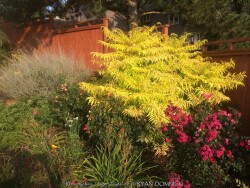

When Tiger Eyes® sumac (Rhus typhina 'Tiger Eyes') was released, it shocked the horticulture world with unseen beauty. It started as a random mutation from cutleaf staghorn sumac (Rhus typhina 'Laciniata') that was successfully propagated. Foliage emerges in spring as a lovely chartreuse color tinged with pink new growth and contrasting leaf petioles. Growth matures to a bright yellow golden color throughout the summer. By October, especially before and around Halloween, foliage turns bright orange with hints of red. Foliage quickly freezes and drops off for the year when temperatures reach 30 degrees F. The overall architectural shape of the shrub is attractive in winter often looking like a deciduous bonsai tree up to 6 feet tall. While the original species, staghorn sumac (R. typhina), is highly aggressive and considered invasive in the garden, the Tiger Eyes cultivar (lacking as much chlorophyll) is quite a bit less aggressive from rhizomes. Some spreading will occur each year and can be clipped off with no further efforts by the plant to spread until the following year. However if soil conditions are rich and moist, some spreading can still occur. This also makes the plant more susceptible to verticillium wilt so it's best to just avoid these kind of pampered garden conditions. We recommend planting Tiger Eyes sumac on berms, tops of retaining walls and/or non-irrigated gardens in poor/dry soils. Another good micro-climate is the hot South or West side of a house; heat and drought are never an issue with no foliage burn in our zone 6a garden of Eastern Kansas. During some years with excessive humidity and rainfall, foliage can become diseased and drop off before fall color can develop but this does not seem to hurt the plant. This problem is usually avoided if planting in good air circulation in full sun or on top of a berm. Another point of advice with Tiger Eyes sumac is to allow a few nearby shoots from the root system to grow and eventually replace the mother plant. Individual top growths will usually last about 5 to 7 years before declining and dying. A plant in our display gardens has survived 15 years using this previously described method. Nowadays, there are several different ornamental shrub choices for gold summer color and while tiger eyes sumac was one of the first, it is still a great choice. Rhus typhina 'Bailtiger' TIGER EYES® if offered for sale, are original (non-propagated) plants from Bailey Nurseries Inc.
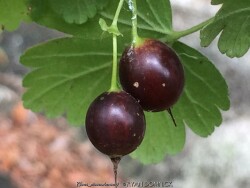

Missouri Gooseberry (Ribes missouriense) is a spreading shrub native to the north central United States including Kansas. It features green leaves that remain attractive all summer. Light yellow to whitish-green flowers are noticeable and attractive upon close inspection. Green semi-translucent berries develop in summer and ripen to a purplish-black color by late summer and early fall. Tart berries are attractive and highly edible when eaten fresh or baked into pies. Any fruits not eaten by humans are harvested by wildlife. Fall color is reddish-orange and will occur in sun or shade. This shrub eventually grows into a dense thicket 3-5' tall with small thorns or prickles. It will grow in part sun or full shade in medium to dry soils including dry-shade. In the landscape, it is commonly used as background planting on a hill or along a fence. It also makes a great barrier shrub naturally discouraging trespassers. Because of its tolerance for adverse conditions including poor soil and rock, it is often one of the last resort plants that will survive in certain areas especially in the worst of all dry-shade areas. It competes well under large shade trees and helps absorb leaf litter allowing it to break down and add nutrients back to the soil. Plants can also be planted on the Northside of a house, being extremely cold hardy with no winterkill. We do not recommend planting in small areas or in spaces that will overrun neighboring plants. It can spread by shallow horizontally growing roots but not very far. It will grow in moist rich soils but will spread quite a bit faster and grow taller. (and produce more fruit) You'll have to decide if that's desirable or not for your planting location. I have seen this plant growing exclusively in heavily shaded rocky outcroppings around Clinton lake near Lawrence Kansas with almost no other plants growing there except Coralberry(Symphoricarpos orbiculatus). Considered one of the best plants for solving your most difficult dry-shade landscape challenges.
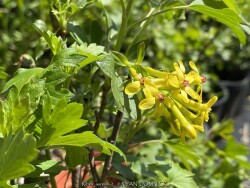

***Shrub descriptions available with future update!*** Ribes odoratum is also known as Golden Currant / Gooseberry.
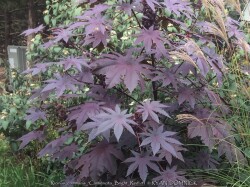

Castor Bean (Ricinus communis) is a giant annual grown for its large star shaped leaves and highly ornamental summer flowers and spiky seed pods. Being one of the fastest growing plants, it will germinate from a seed and can reach 5 feet tall in one month. Ultimate height at the end of the season is usually 8 to 12 feet. Growth rate, however, is directly proportional to available water and soil quality. In poor dry soil areas, a height of 3 feet may be achieved with some flowering by fall. In the landscape, this amazing annual can be used for lots of coverage is needed quick. Maintenance is considered medium. Staking by mid-summer may be necessary to prevent plants from blowing over. All dead foliage should be removed right before or promptly after the first fall freeze. At that time, seeds can be clipped off and immediately planted if you would like castor beans to return next spring. Seeds may also be harvested and stored and will not survive winter outside unless planted or covered by a deep layer of mulch. If planting seed in the spring, wait till soil warms up in early May. Seeds germinate quickly and extremely easily with almost no effort. Castor Bean plants do not easily overwinter indoors as a house plant due to their need for tropical growing conditions and high humidity. Another word of caution is that castor bean seeds are extremely toxic. However there is almost never any poisonings because the seed tastes so bad if chewed that anyone in their right mind would spit it out. Seeds that are swallowed whole usually survive the digestive system and not cause poisoning. The plant itself is not very toxic so there is no reason not to grow it. If you are concerned about the beans, or you have small children, just cut off and dispose of the flowers after they bloom and before seeds ripen. You'll have plenty of time (1-2 months) before the bright red spiky seed pods open and turn brown. Purple Castor Bean (Ricinus communis 'Carmencita Bright Red') features bright reddish-purple foliage and dark red seed pods. Overall size is smaller with slower growth rate.
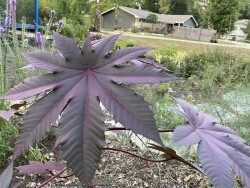

Castor Bean (Ricinus communis) is a giant annual grown for its large star shaped leaves and highly ornamental summer flowers and spiky seed pods. Being one of the fastest growing plants, it will germinate from a seed and can reach 5 feet tall in one month. Ultimate height at the end of the season is usually 8 to 12 feet. Growth rate, however, is directly proportional to available water and soil quality. In poor dry soil areas, a height of 3 feet may be achieved with some flowering by fall. In the landscape, this amazing annual can be used for lots of coverage is needed quick. Maintenance is considered medium. Staking by mid-summer may be necessary to prevent plants from blowing over. All dead foliage should be removed right before or promptly after the first fall freeze. At that time, seeds can be clipped off and immediately planted if you would like castor beans to return next spring. Seeds may also be harvested and stored and will not survive winter outside unless planted or covered by a deep layer of mulch. If planting seed in the spring, wait till soil warms up in early May. Seeds germinate quickly and extremely easily with almost no effort. Castor Bean plants do not easily overwinter indoors as a house plant due to their need for tropical growing conditions and high humidity. Another word of caution is that castor bean seeds are extremely toxic. However there is almost never any poisonings because the seed tastes so bad if chewed that anyone in their right mind would spit it out. Seeds that are swallowed whole usually survive the digestive system and not cause poisoning. The plant itself is not very toxic so there is no reason not to grow it. If you are concerned about the beans, or you have small children, just cut off and dispose of the flowers after they bloom and before seeds ripen. You'll have plenty of time (1-2 months) before the bright red spiky seed pods open and turn brown. Purple Castor Bean (Ricinus communis 'New Zealand Purple') features bright purple foliage and dark red seed pods.
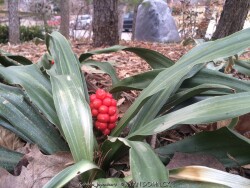

Chinese Sacred Lily (Rohdea japonica) is a tropical-looking evergreen herbaceous perennial native to China and Japan. They are considered the ultimate dry-shade plant for eastern Kansas landscapes. They have everything a gardener might ask for; dependable dark green foliage, colorful red long-lasting fruits, evergreen during winter, and ease of care with very low maintenance. Evergreen foliage is daylily-like and hardy to about -10°F. If it gets colder than that, rohdea will be deciduous with no detrimental effects. The red fruits in the crowns of established plants persist many months through the winter! Rohdeas are also not the best choice for full sun. While they will survive, they will get foliage burn in the summer when over 100°F in afternoon sun. With poisonous foliage, these plants resist deer and rabbit browsing. Rohdea tolerates most soils except for poorly drained ones. Growth is quite slow with young plants but speeds up with establishment and rich soils with regular water. Established plants have thrived in our Lawrence Kansas zone 6a display garden for over 15 years enduring temperatures as low as -18°F. and periods with many days in a row in the single digits and negative low temps. Repeated or successive cold winters with complete foliage loss can be an issue with this and many evergreen zone 6/7 plants. One occasional difficult winter followed by mild winters is more tolerable. It's tolerance for deep shade makes up for this though. What a great plant for the dry shade garden!
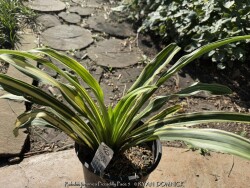

Chinese Sacred Lily (Rohdea japonica) is a tropical-looking evergreen herbaceous perennial native to China and Japan. They are considered the ultimate dry-shade plant for eastern Kansas landscapes. They have everything a gardener might ask for; dependable dark green foliage, colorful red long-lasting fruits, evergreen during winter, and ease of care with very low maintenance. Evergreen foliage is daylily-like and hardy to about -10°F. If it gets colder than that, rohdea will be deciduous with no detrimental effects. The red fruits in the crowns of established plants persist many months through the winter! Rohdeas are also not the best choice for full sun. While they will survive, they will get foliage burn in the summer when over 100°F in afternoon sun. With poisonous foliage, these plants resist deer and rabbit browsing. Rohdea tolerates most soils except for poorly drained ones. Growth is quite slow with young plants but speeds up with establishment and rich soils with regular water. Established plants have thrived in our Lawrence Kansas zone 6a display garden for over 15 years enduring temperatures as low as -18°F. and periods with many days in a row in the single digits and negative low temps. Repeated or successive cold winters with complete foliage loss can be an issue with this and many evergreen zone 6/7 plants. One occasional difficult winter followed by mild winters is more tolerable. It's tolerance for deep shade makes up for this though. What a great plant for the dry shade garden! Rohdea japonica 'Variegata' is a beautiful variegated variety with dark green and yellow stripes; very dramatic in winter!
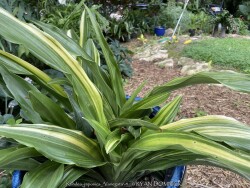

Chinese Sacred Lily (Rohdea japonica) is a tropical-looking evergreen herbaceous perennial native to China and Japan. They are considered the ultimate dry-shade plant for eastern Kansas landscapes. They have everything a gardener might ask for; dependable dark green foliage, colorful red long-lasting fruits, evergreen during winter, and ease of care with very low maintenance. Evergreen foliage is daylily-like and hardy to about -10°F. If it gets colder than that, rohdea will be deciduous with no detrimental effects. The red fruits in the crowns of established plants persist many months through the winter! Rohdeas are also not the best choice for full sun. While they will survive, they will get foliage burn in the summer when over 100°F in afternoon sun. With poisonous foliage, these plants resist deer and rabbit browsing. Rohdea tolerates most soils except for poorly drained ones. Growth is quite slow with young plants but speeds up with establishment and rich soils with regular water. Established plants have thrived in our Lawrence Kansas zone 6a display garden for over 15 years enduring temperatures as low as -18°F. and periods with many days in a row in the single digits and negative low temps. Repeated or successive cold winters with complete foliage loss can be an issue with this and many evergreen zone 6/7 plants. One occasional difficult winter followed by mild winters is more tolerable. It's tolerance for deep shade makes up for this though. What a great plant for the dry shade garden! Rohdea japonica 'Variegata' is a beautiful variegated variety with dark green and yellow stripes; very dramatic in winter!
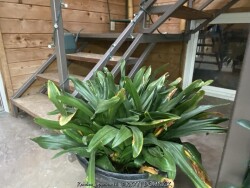

Chinese Sacred Lily (Rohdea japonica) is a tropical-looking evergreen herbaceous perennial native to China and Japan. They are considered the ultimate dry-shade plant for eastern Kansas landscapes. They have everything a gardener might ask for; dependable dark green foliage, colorful red long-lasting fruits, evergreen during winter, and ease of care with very low maintenance. Evergreen foliage is daylily-like and hardy to about -10°F. If it gets colder than that, rohdea will be deciduous with no detrimental effects. The red fruits in the crowns of established plants persist many months through the winter! Rohdeas are also not the best choice for full sun. While they will survive, they will get foliage burn in the summer when over 100°F in afternoon sun. With poisonous foliage, these plants resist deer and rabbit browsing. Rohdea tolerates most soils except for poorly drained ones. Growth is quite slow with young plants but speeds up with establishment and rich soils with regular water. Established plants have thrived in our Lawrence Kansas zone 6a display garden for over 15 years enduring temperatures as low as -18°F. and periods with many days in a row in the single digits and negative low temps. Repeated or successive cold winters with complete foliage loss can be an issue with this and many evergreen zone 6/7 plants. One occasional difficult winter followed by mild winters is more tolerable. It's tolerance for deep shade makes up for this though. What a great plant for the dry shade garden!
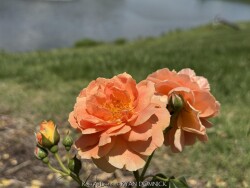

Finally - a fragrant, disease-resistant rose! It's the dawn of a new day for roses: At Last® combines all the romance of a fragrant, fully-petaled tea rose with the no-nonsense practicality of a disease-resistant landscape rose. No spraying is required to enjoy a non-stop display of large, sweetly perfumed sunset-orange blossoms from late spring through frost. Handsome, glossy foliage and a vigorous, rounded habit makes it ideal for use in the landscape or the flower garden. Now available in garden centers near you! With new rose varieties, we are careful not to recommend planting roses in large mass groupings in case a pest or disease becomes a problem. Mixed small plantings of roses and non-host plants may slow the spread of RRV in landscape plantings. As with most roses, thorns may be an issue with children or pets. Usually rose thorns are short and don't cause any serious injury: it creates more of a life lesson about respecting and being careful around the dangers in our world. All Proven Winners® plants are legally propagated, healthy and vigorous, true to name, and tagged with color pictures and growing information.


This rose earns its spot in the Winner's Circle! There's so much to love about Oso Easy Double Red® rose - its lush, deep red color. The way the blooms are held on long stems, well above the foliage, for a truly memorable display. And speaking of foliage, it's a beautiful, lustrous green with excellent resistance to powdery mildew and black spot, so it stays looking good all season. No need to deadhead to keep those beautiful blooms coming, too! Oso Easy Double Red rose is a bit of a bigger plant - about 3-4'/.9-1.2 m tall and wide, but give it enough space in a sunny location, and you've given yourself the gift of an easy-care rose that you'll love to look at all season long. In Lawrence Kansas, performance has been impressive and low maintenance. Currently, no serious pest problems exist but we are careful not to recommend planting roses in large mass groupings in case a pest or disease like Rose Rosette Virus (RRV) becomes a problem. Mixed small plantings of roses and non-host plants may slow the spread of RRV in landscape plantings. As with most roses, thorns may be an issue with children or pets. Usually rose thorns are short and don't cause any serious injury: it creates more of a life lesson about respecting and being careful around the dangers in our world. All Proven Winners® plants are legally propagated, healthy and vigorous, true to name, and tagged with color pictures and growing information.


Spice up your landscape! Oso Easy® Paprika rose is a landscape classic - and now, it has a modern update. Meet Oso Easy Hot Paprika® - like its namesake, it flowers from early summer through frost on a versatile, low-growing plant. It also shares its outstanding hardiness and disease resistance. Its flowers, however, light up the garden in an electric glowing orange for a bold new look. Available in better garden centers in spring 2018. In Lawrence Kansas, performance has been impressive and low maintenance. Currently, no serious pest problems exist but we are careful not to recommend planting roses in large mass groupings in case a pest or disease like Rose Rosette Virus (RRV) becomes a problem. Mixed small plantings of roses and non-host plants may slow the spread of RRV in landscape plantings. As with most roses, thorns may be an issue with children or pets. Usually rose thorns are short and don't cause any serious injury: it creates more of a life lesson about respecting and being careful around the dangers in our world. All Proven Winners® plants are legally propagated, healthy and vigorous, true to name, and tagged with color pictures and growing information.
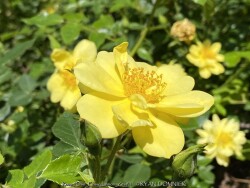

Still think yellow roses are tough to grow? Not this rebel! We evaluated yellow roses for years, looking for one that lived up to our demands for brilliant color and excellent disease-resistance. This is it! Sunny, canary yellow flowers do not fade to white, and really light up against the glossy green foliage. It is free-flowering, producing lots of buds which open to self-cleaning flowers. Superior disease-resistance makes it easy for gardeners to enjoy. Winner of an Award of Excellence from the American Rose Society. In Lawrence Kansas, performance has been impressive and low maintenance. Currently, no serious pest problems exist but we are careful not to recommend planting roses in large mass groupings in case a pest or disease like Rose Rosette Virus (RRV) becomes a problem. Mixed small plantings of roses and non-host plants may slow the spread of RRV in landscape plantings. As with most roses, thorns may be an issue with children or pets. Usually rose thorns are short and don't cause any serious injury: it creates more of a life lesson about respecting and being careful around the dangers in our world. All Proven Winners® plants are legally propagated, healthy and vigorous, true to name, and tagged with color pictures and growing information.


If you think roses are for very proper, formal gardens, think again. This rebel has intense, amazing color: shades of ruby-red grapefruit, summer sunsets, and those fancy tropical drinks with umbrellas in them. The continuous blooms cover the tidy mound of dark, glossy foliage. This is a wonderful choice for mass plantings or adding unusual color to mixed borders In Lawrence Kansas, performance has been impressive and low maintenance. Currently, no serious pest problems exist but we are careful not to recommend planting roses in large mass groupings in case a pest or disease like Rose Rosette Virus (RRV) becomes a problem. Mixed small plantings of roses and non-host plants may slow the spread of RRV in landscape plantings. As with most roses, thorns may be an issue with children or pets. Usually rose thorns are short and don't cause any serious injury: it creates more of a life lesson about respecting and being careful around the dangers in our world. All Proven Winners® plants are legally propagated, healthy and vigorous, true to name, and tagged with color pictures and growing information.
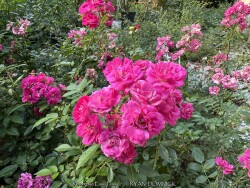

***Shrub descriptions available with future update!*** Rosa 'Oso Easy Peasy' is also known as Oso Easy Easy Peasy Pink Shrub Rose.


A bright red rose with non-stop blooms! Oso Easy® Urban Legend® is a bright and vigorous member of this best-selling series of disease-resistant landscape roses. True-red, semi-double flowers in early summer and continue through the first hard frost. A crown of lush yellow stamens in the center add interest and contrast. Dark green glossy foliage resists powdery mildew and black spot.In Lawrence Kansas, performance has been impressive and low maintenance. Currently, no serious pest problems exist but we are careful not to recommend planting roses in large mass groupings in case a pest or disease like Rose Rosette Virus (RRV) becomes a problem. Mixed small plantings of roses and non-host plants may slow the spread of RRV in landscape plantings. As with most roses, thorns may be an issue with children or pets. Usually rose thorns are short and don't cause any serious injury: it creates more of a life lesson about respecting and being careful around the dangers in our world. All Proven Winners® plants are legally propagated, healthy and vigorous, true to name, and tagged with color pictures and growing information.
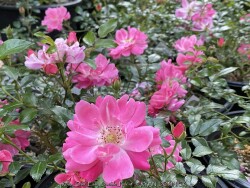

Imagine your garden with non-stop pink roses! Oso Easy® Double Pink rose is simply an unstoppable bloomer. In our many years evaluating it, it was rarely without its fully petaled, true pink blooms - it just wants to flower and flower and flower. All roses that we consider must prove to be resistant to common rose maladies like powdery mildew and black spot and Oso Easy Double Pink passed that test with flying colors! If you want to enjoy months of flowers with minimal effort, this rose deserves a spot in your landscape. In Lawrence Kansas, performance has been impressive and low maintenance. Currently, no serious pest problems exist but we are careful not to recommend planting roses in large mass groupings in case a pest or disease like Rose Rosette Virus (RRV) becomes a problem. Mixed small plantings of roses and non-host plants may slow the spread of RRV in landscape plantings. As with most roses, thorns may be an issue with children or pets. Usually rose thorns are short and don't cause any serious injury: it creates more of a life lesson about respecting and being careful around the dangers in our world. All Proven Winners® plants are legally propagated, healthy and vigorous, true to name, and tagged with color pictures and growing information.


Rosemary is one of the most well-known herbal and edible plants. It features grayish green aromatic and evergreen foliage with small white flowers. Blooming is usually short-lived and not a main reason to grow Rosemary. This plant is native to Mediterranean climates with average moisture in the summer and dry, mild winters. Because of its heritage, it resents cold wet winters and needs well-drained sandy, silty, or rocky soil. In the short term, it will typically grow in any soil during the summer making it very useful even as an annual. In Kansas landscapes, it is commonly used as an annual or short-lived perennial with winter kill (below 0 to -10 degrees F) being it's number one enemy. It does not have very good ability to come back from the lower portion of the stem or root system like other perennials after winter-kill. Root rot is also likely when placed in poor draining soil and sometimes even in rich garden soil. Summer heat not a problem; to have a chance of survival as a perennial, plant in a protected area on a South or West wall. Rosemary is actually a woody shrub in mild zone 8 and 9 climates and grown like a in perennial in zone 6/7. When grown as a perennial, every so often you do need to trim it back to a few inches off the ground. Rosemary combines nicely with any other flowers or where needing a perennial with evergreen winter color. In Kansas, Rosemary is commonly grown as an outdoor patio plant that you move in for the winter to enjoy fresh clippings. When grown that way, remember that Rosemary is cold hardy to about 0 degrees F so you can skip the first few freezes before moving it in if you forget. This delay is probably beneficial because if you keep it in the house too long especially with poor light it will display poor quality elongated growth and die. Keep in a bright window and do not let it dry out completely. Strangely enough being from a desert climate, rosemary doesn't really warn you by wilting, if the soil gets extremely dry for too long, it just suddenly dries up and dies. Despite all of these pointers, rosemary is very easy to overwinter in the house when placing back out in the following spring. 'Arp' is exceptionally cold hardy; possibly the most cold hardy rosemary being a treu perennial in zone 6 with dark blue hummingbird feeding flowers.
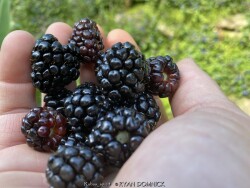

Blackberry (Rubus sp.) is an "easy to grow" edible fruit that is worth growing in Kansas. Store-bought blackberries are expensive and don't taste as good as garden grown fruits. All cultivars of blackberries have perennial roots, but most top shoots only live for two years. (meaning shoots grow in the first growing season and fruits grow on those shoots during the second growing season) The cycle is repeated; maintenance involves removing old canes after decline or death. Raspberries are vigorous and can be locally invasive in the garden but rarely invasive in the wild. They propagate by basal shoots (also known as suckers) spreading some distance from the main plant. After establishment, it is high maintenance if it has already filled the space and you don't want it to spread any further so plan accordingly. In the landscape, raspberry and blackberry mix well into garden designs with ornamental plants as long as you create it's own area (like a background fence to train plants on) The main difference between raspberry and blackberry are that the fruit releases from the raspberry differently. The "torus" or inside center of the fruit is hollow and releases from the stem with raspberry. With Blackberry, the "torus" or center "picks with" the fruit giving a solid fruit to eat. (just in case you have always wondered) Our supplier, Spring Meadows Nursery has this to say about this new PROVEN WINNERS plant: Taste of Heaven blackberry (Rubus 'Ponca') is the sweetest, most flavorful blackberry on the market - and now you can grow it at home. We know, that's a tall claim, but you don't need to take our word for it: this article in the journal HortScience confirms it. And we know because we tasted literally hundreds of different blackberry varieties before deciding this would be the one to make it on to further testing. Taste of Heaven is a vigorous, thornless blackberry that produces large, luscious fruits over several weeks in summer. It's a floricane variety, fruiting only on second-year canes, and does not strictly require trellising or support, though in the garden, it is easier to care for and harvest with something in place.
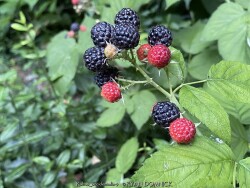

Raspberry (Rubus occidentalis) is an "easy to grow" edible fruit that is worth growing in Kansas. Store-bought raspberries are expensive and don't taste as good as garden grown fruits. All cultivars of raspberries have perennial roots, but most top shoots only live for two years. (meaning shoots grow in the first growing season and fruits grow on those shoots during the second growing season) The cycle is repeated; maintenance involves removing old canes after decline or death. Raspberries are vigorous and can be locally invasive in the garden but rarely invasive in the wild. They propagate by basal shoots (also known as suckers) spreading some distance from the main plant. After establishment, it is high maintenance if it has already filled the space and you don't want it to spread any further so plan accordingly. In the landscape, raspberry and blackberry mix well into garden designs with ornamental plants as long as you create it's own area (like a background fence to train plants on) The main difference between raspberry and blackberry are that the fruit releases from the raspberry differently. The "torus" or inside center of the fruit is hollow and releases from the stem with raspberry. With Blackberry, the "torus" or center "picks with" the fruit giving a solid fruit to eat. (just in case you have always wondered) Native Black Raspberry (Rubus occidentalis) is a true native plant to Kansas lightly shaded woods, open moist prairies, disturbed areas (especially those that are logged or cut), and near streams and lakes, trails or roadways. Ripe fruit is black instead of red. Fruit production is rather brief compared to commercially available varieties (one big flush of fruits ripen for a couple weeks and that's it) Foliage is bluish-green with powdery white flocked backsides and irridescent bluish-purple stems add nice ornamental value! Also called black cap raspberry.